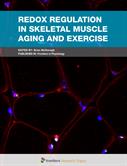Redox Regulation in Skeletal Muscle Aging and Exercise

Download Url(s)
http://journal.frontiersin.org/researchtopic/2723/redox-regulation-in-skeletal-muscle-aging-and-exerciseAuthor(s)
Brian McDonagh
Language
EnglishAbstract
Skeletal muscle represents the largest organ of the human body and comprises about 40% of total body mass in humans. Even in people who ‘age well’, there is a noticeable loss of muscle strength and function that accelerates dramatically after the age of 60, a major factor in the reduction in life quality for the aging population. One of the most effective interventions to maintain muscle mass and function is through exercise. Skeletal muscle generates reactive oxygen and reactive nitrogen (ROS/RNS) species in response to muscle contractions. The concentration and species of ROS/RNS generated can depend on the age and fitness of the individual, muscle fibre type and the intensity of the muscle contractions. ROS/RNS generate unique signaling cascades that are not only essential in skeletal muscle contraction and adaptation but also play a role in a wide array of cell processes including cell proliferation, protein synthesis/degradation, immune response and antioxidant defense. ROS/RNS generated by contractions are involved in a co-ordinated local response that is tightly controlled at all levels from generation to detoxification. This collection of original articles and reviews highlights investigations that measure different aspects of the redox response of skeletal muscle to aging and exercise.
Keywords
Mitochondria; Sternohyoid muscle; uremic myopathy; sphingomyelinase; Muscle Fatigue; sirt3; Calveolin-3; NADPH OxidaseWebshop link
http://www.frontiersin.org/boo ...ISBN
9782889451968Publisher
Frontiers Media SAPublisher website
www.frontiersin.orgPublication date and place
2017Series
Frontiers Research Topics,Classification
Physiology

